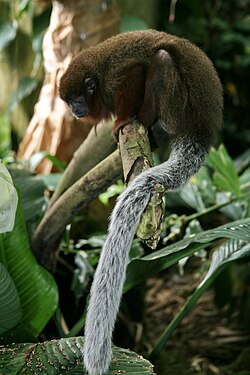| Plecturocebus | |
|---|---|
 | |
| Brown titi (Plecturocebus brunneus) | |
| Scientific classification | |
| Kingdom: | Animalia |
| Phylum: | Chordata |
| Class: | Mammalia |
| Order: | Primates |
| Suborder: | Haplorhini |
| Infraorder: | Simiiformes |
| Family: | Pitheciidae |
| Subfamily: | Callicebinae |
| Genus: | Plecturocebus Byrne, Rylands, Carneiro, Lynch Alfaro, Bertuol, da Silva, Messias, Groves, Mittermeier, Farias, Hrbek, Schneider, Sampaio & Boubli, 2016 |
| Type species | |
| Cebus moloch [1] Hoffmannsegg, 1807 | |
| Species | |
See text. | |
Plecturocebus is one of three genera of titi monkeys.
Historically, titi monkeys were considered monogeneric, being placed in a single genus: Callicebus Thomas, 1903. Owing to the great diversity found across titi monkey species, a new genus-level taxonomy was proposed in 2016 that recognises three genera within the subfamily Callicebinae; PlecturocebusByrne et al., 2016 for the Amazonian and Chaco titis of the moloch and donacophilus groups; Cheracebus Byrne et al., 2016 for the species of the torquatus group (Widow titis); and CallicebusThomas, 1903sensu stricto, for species of the Atlantic Forest personatus group. [1]
Plecturocebus is derived from the Latin forms of three Greek words: plektos, meaning twist or plait, oura, meaning tail, and kebos, meaning long-tailed monkey. All together, this refers to the behavior of many titi monkeys to intertwine their tails when they sit next to each other. [1]





